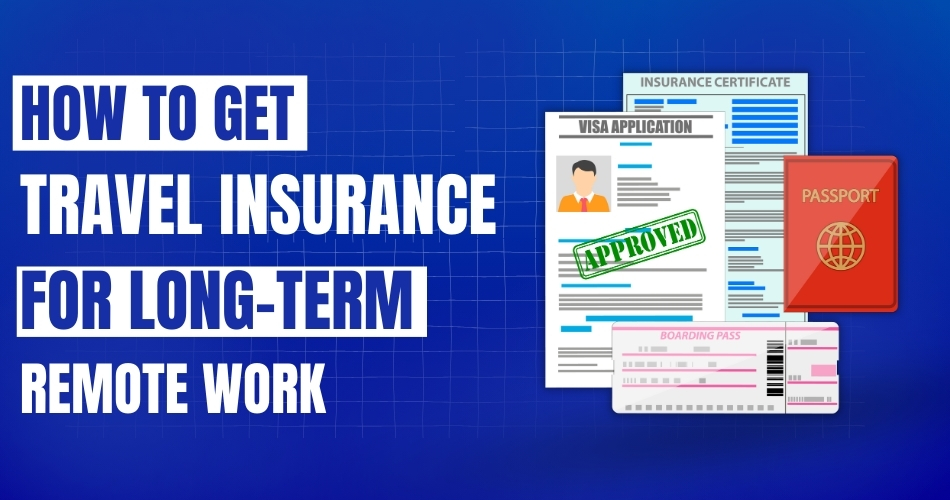With the growing popularity of remote work, more people are realizing that it is possible to be free to work from any part of the world. Be it a wandering digital nomad or someone who has relocated to a new city for work, you will definitely want a travel insurance policy—the one that covers long-term remote workers. Long-term travel insurance is one category that needs proper planning to ensure you have maximum coverage for a long stay. And this is the guide to help you get travel insurance in place while it is absolutely essential to focus on the job and not think about any medical emergency, cancellation, or lost belongings coming on your way.
Overview: What Are Long-Term Travel Insurance Policies?
Long-term travel insurance is a policy taken by those intending to be away for an extended period, usually more than six months from their country of residence. There are certain obvious differences between typical travel insurance, which is valid for a short period, and long-term travel insurance packages, designed to provide continuous coverage for several months to even a year or more, depending on the provider. These can usually range from medical emergencies to a lost or stolen item, and in some cases, an interruption to your work.
Why Travel Insurance Is Important for Remote Workers
While working remotely from a beach in Bali or a café in Paris sounds amazing, here’s the deal: life’s curveballs don’t take a break. Travel insurance is especially important for long-term remote workers for several reasons:
Medical Coverage: Health systems greatly vary from country to country, and medical care is usually very expensive, especially when it comes to an emergency. Travel insurance entitles you to health care in which the full out-of-pocket cost is not your responsibility.
Trip Cancellation or Interruption: If your journey is canceled or interrupted by events like natural disasters, illness, or political unrest, this insurance helps recover prepaid expenses. It covers costs for flights, hotels, and other prepaid bookings you made.
Lost or Stolen Property: Laptops, smartphones, and other work essentials can be easily lost or damaged while traveling. Travel insurance can help replace these items, allowing work to continue with minimal disruption.
Liability Coverage: If you visit clients’ offices, share workspaces, or engage in activities that could lead to third-party claims, liability coverage protects you from potential lawsuits or claims due to accidents or damages.
Medical Insurance: Hospital stays, surgery, doctor visits, and unexpected dental emergencies may all be covered. Ensure your policy includes medical evacuation, which can transport you to the nearest suitable facility or even back to your home country if needed.
How to Choose a Policy
There are many factors to be kept in mind while choosing the right travel insurance policy for long-term remote work. They include the following:
Duration of coverage: Be sure that the policy will cover your complete stay. For some, in case of a change in your plans, the trip might be extended.
Geographic Coverage: The policy should offer you coverage throughout your destination places. Some destinations may be excluded due to political instability or high levels of crime in that area.
Pre-existing condition: In case of any pre-existing medical condition, be aware of the details of the coverage for such a condition in the policy. Some will call for an additional premium, others treat them poorly.
Exclusions and Limitations: The fine print of the policy will give you ideas of what is excluded. Some common exclusions could be things like the actual practice of hazardous activities—extreme sports, for example—or travel to dangerous zones.
Cost: Get costs from several providers by considering a number of other premiums. It might, at times, be very tempting—going for the cheapest—but ensure that the policy has adequate coverage for your needs.
Customer Support and Claims Process: Go for one with whom you can avail good customer support and through which the claim process is smooth and easy. You never know when you would need their support, God forbid, under any emergency.
How to Get Long-Term Travel Insurance
Here is a step-by step guide to getting travel insurance for long-term remote work:
Step 1: Assess Your Needs
First, list down what you really need for your specific destination, duration of the trip, and type of work you will be doing. If you’re traveling to a country where medical procedures are expensive, then obviously, all medical coverage should be put on top of the list.
Step 2: Look Into Insurance Providers
Survey options that are designed for long-term travel or that target digital nomads. Some good places to find this kind of information are online reviews, forums, and other comments in the remote work community.
Step 3: Compare Policies
Having listed a few providers, you now go through the policies to see how they compare to each other. Note the amount of coverage, the exclusions, or any other highlighted features that sound useful to you, for example, emergency support with 24/7 services or high-risk coverage .
Step 4: Get a Quote
Many insurance companies do have online platforms where one has to fill in the travel details, and automatically, you will be furnished with the approximate premium. Quotation by several providers will help you assure you are indeed getting the best offer.
Step 5: Purchase the Policy
Buy the policy which best serves you after you have selected one. Understand the terms and conditions fully before paying for it.
Step 6: Storing your policy information securely
Keep digital and printed copies of your insurance policy in an accessible place. Do share it with a trusted friend or family member in case of any emergency.
Step 7: Be informed and current
Read your policy often and amend it in case you change the circumstances, for example by extending your stay or visiting more countries.
Pitfalls to Avoid
Purchasing long-term travel insurance as a remote worker, take careful steps to avoid these potential pitfalls:
Ignorance of Fine Print:
It is the result of failure to read and comprehend the contents of the fine print in the policy document.
Cheap Buying on Medical Coverage:
One should not be a cheapskate in buying the cover for medical expenses, particularly if you will be visiting a country in which healthcare services are very expensive.
Overlooked Exclusions:
Activities such as scuba diving, skiing, or even riding a motorcycle should definitely have been exclude from the activities list. If you are aware that you are likely to engage in any documented activity. Then find policies that specifically include them.
Not Sharing Pre-existing Conditions:
Do share the condition of your health. Non Disclosure can result in the rejection of claims.
Do Not Buy in a Hurry—Delay Buying Insurance:
Do not buy your travel insurance policy in a hurry. Many benefits, like trip cancellation coverage, come into effect only if you buy your policy with enough time left to start your journey.
How Aapkapolicywala helps in long-term travel insurance
This is where Aapkapolicywala will play an important role when it comes to your long-term travel insurance for working remotely. On Aapkapolicywala, you are compare with several insurance policies to ensure that you obtain the best-priced value. Rely on customer support experts who simplify insurance for you, ensuring it doesn’t feel overwhelming. This way, you stay fully covered while working remotely abroad.
Conclusion:
Make sure you select the right travel insurance to stay protected from unexpected issues during remote work. Focus on your job confidently, knowing that coverage will keep you prepared. Understanding coverage options, evaluating policies, and avoiding pitfalls are essential for a smooth journey. Platforms like AapkaPolicyWala help you find the best insurance from the comfort of your own space, giving you peace of mind while working anywhere your adventures take you.

